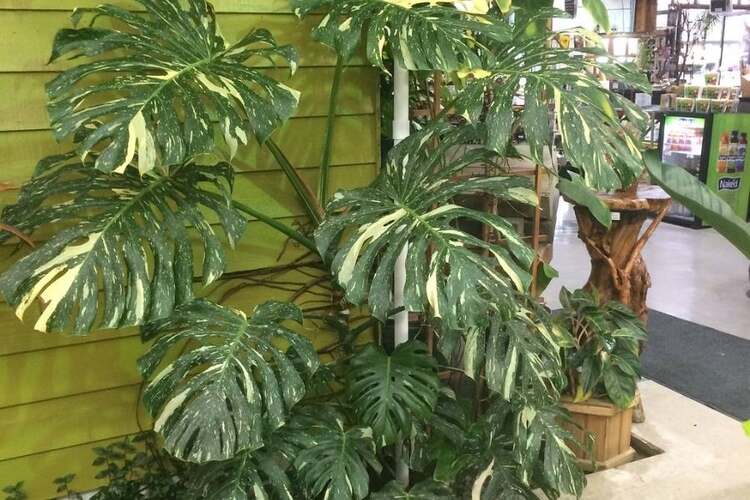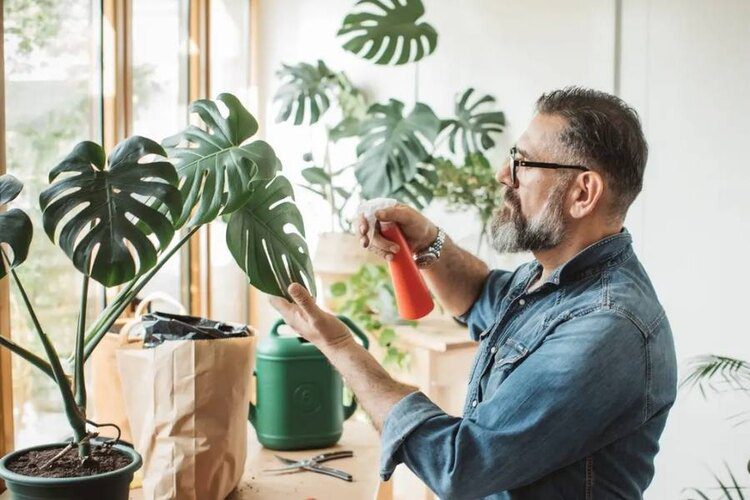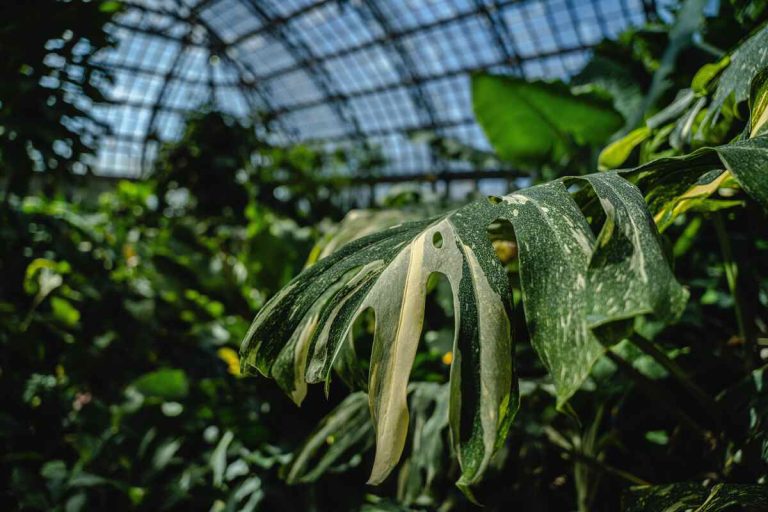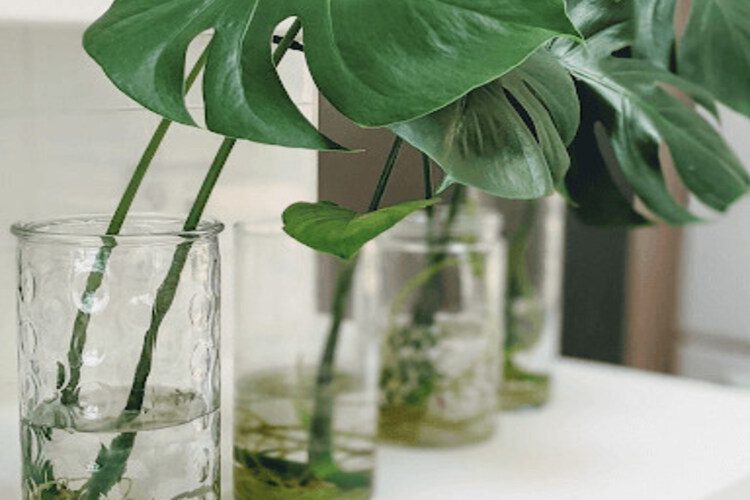Do Monsteras Like To Be Root Bound? The Truth Of Root Bound

Some people assume that keeping Monstera plants in small containers will encourage their development because they prefer to be root-bound. Do Monsteras like being root bound?
The short answer is no! Monstera plants do not like being root-bound and prefer to have enough space to grow their root systems and develop. If you are a newbie gardener, it’s best to learn more about how to take care of this plant variety so that it grows at its best. Scroll down for details!
Do Monstera Like Being Root Bound?
No. Monstera plants do not like being root-bound. This is a common Monstera problem that occurs when the roots of the plant outgrow the pot. When this happens, the roots cannot get enough water and nutrients, and the plant can start to decline. As a result, root-bound Monsteras lack the ability to absorb nutrients and water from the soil due to their crowded and compressed roots. The phenomenon can bring about the worst outcomes, including the death of the ornamented herb. Without a doubt, finding out if your Monsteras need to be repotted is undoubtedly a difficult task. Yet, if the plants get root-bound, you must quickly relocate them to a larger pot.
Sadly, most unskilled horticulturalists believe that the beautiful Monstera plants prefer to be kept in a small pot with their vivid foliage. Because root-bound Monstera lacks sufficient potting material and breathing space, the plants lack water, minerals, and oxygen. Furthermore, the crowded rootball cannot absorb moisture from the soil surface. As a result, the plant’s growth is limited; the roots decompose, and the leaves become shrivelled and pale.

What Do You Know About Monstera Plants?
They belong to the Arum family. They can be easily found in southern Mexico and Panama, where they can grow 20 meters tall. In Southeast Asian forests, they use their fleshy, fibrous roots to cling to rocks, tree trunks, and soil.
Monstera deliciosa is the most well-known species. The word “deliciosa” refers to a tasty 20-centimetre-diameter fruit that was once popular in Central America. Due to its fast-spreading aerial roots and leaf-bearing vines, Monstera deliciosa signifies suffocation. That’s why many people love to interpret their connotation depending on Chinese symbolism, in which the Monstera represents a longer lifespan and respect for seniors and respectable people.
Monsteras are easily identified by their huge green leaves, but there are several variations. Young leaves have a heart shape. If supplied with sufficient water and light, the leaves flourish and form deep incisions. Adult ones can grow up to 1 metre in diameter.
What Does It Mean To Be Root Bound?
A root-bound Monstera’s stem is constrained by the planted pot. Although it is seeking to extend and flourish, it is confined and unable to do so. Roots that curl around themselves or circle around the bottom of the container create a fully covered network of twisted stems that provide no place for water, oxygen, or soil. The roots are also compressed. They squish together until they create one solid block. Roots develop into tiny spaces of leaves or even other detritus lodged in the crevices of stems, in which they can survive and flourish.
When they expand their extent, all these roots frequently develop out of the drainage holes underneath the container. Dripping water is a common symptom of a root-bound Monstera. Being a root-bound Monstera has several negative impacts; the most serious is dehydration. The soil is supposed to contain nutrients and water for the plants. However, once the roots grow too large, the ground can no longer hold them. As a result, the shortage of soil allows water to drain directly through it rather than retain it. This can cause root damage or restricted growth.

How To Check If Your Monsteras Are Root Bound?
As shared earlier, figuring out whether your Monsteras are root-bound or not is a challenging task. How do you know if they are root-bound plants? If you notice any signs below, you should consider repotting them.
Roots Infiltrate Drainage Holes
Monstera roots frequently spread out of drainage holes in the bottom to obtain the necessary nutrients and water. However, this also indicates that their roots have no space to breathe, which can cause the leaves to turn brown.
The Plants Stop Growing.
If a Monstera becomes root-bound, it may not produce new branches, and its growth may be stunted or deformed. If it survives to develop at all, it’ll be weak, slow, and malformed. All new production necessitates using many nutrients and minerals from the growing substrate. If any nutrients are remaining in the soil in the container of a root-bound vine, they might well be lost. The new-growing leaves will exhibit symptoms of a mineral shortage. There would also be signs of root rot. Monsteras that are imperfectly formed, awkwardly shaped, or undersized suffer from lacking the luscious tropical green.
Leaves Wilt And Curl
Monsteras that grow root-bound lack the ability to extract moisture from the ground. Because roots are squeezed against each other, there isn’t enough open surface space for them to absorb nutrients. They’ll gradually grow strained, and all the functions they possess will be lost. The structure and biological function of Monstera are both dependent on water. Whenever the roots aren’t functioning correctly, dehydration occurs. As a result, the leaves curl or wilt.
Roots Grow Above Ground.
When there’s not enough space in the container, the young roots will grow upward instead of downward, as they should normally. Your plants will seek a greater living area by spreading out their stems above the surface of the ground.
What Should You Do If Your Monsteras Are Root Bound?
Although Monsteras dislike being root-bound, they are tolerant species that do not mind getting pressed into small spaces. However, they do grow much faster and have large rhizomes that have plenty of room to expand. As a result, it’s critical to know when to switch from the same pot to a bigger pot.
If your monstera appears to be in good health despite being root-bound, you may continue to grow it in that pot. If the roots keep growing, the plant will grow. At that point, it’s better to consider repotting it so that it has a chance to develop normally. However, waiting until your plant exhibits symptoms of becoming pot-constrained is not a good option since it may cause unnecessary pressure.
It’s recommended to repot Monsteras every two years to ensure they have enough space to grow.

How Do You Know When To Repot A Monstera?
Although there is no specified or standard timeframe for repotting your Monstera, it’s best to change the container every two years, as mentioned above. The time to repot also depends on factors such as plant variant, soil type, climate, or the age of the plant. For instance, whereas a grown plant doesn’t need to get repotted frequently, a young one will need repotting more regularly.
If you keep a young tree with pierced leaves in your home, you should inspect its root systems regularly. It’s best to repot Monsteras before they exhibit symptoms of becoming root-bound to prevent any unnecessary stress on the plant.
How To Repot Monsteras?
If your plant is about to get root-bound, it’s time to move it to a bigger pot. If you are a newbie gardener, it will help to follow the steps below:
Preparation
Choose a container that is not over two inches wider across the top than the previous one. The new container must include at least three holes in the bottom. Monsteras require good drainage. Ensure you have an excellent growing medium to compensate for the volume imbalance between the new and old plants.
Besides, other necessary tools and accessories should include:
- Shears (or scissors)
- A garden trowel (or small shovel)
- Clean water
Step-By-Step Instructions
Step 1: Water the Monstera a day before you intend to change its pot. This will help safeguard the roots.
Step 2: Layer a growing medium to create a base in the new container. 1/3 of the height of the container is preferable, but at least one inch is sufficient.
Step 3: To remove the plant from the pot, tap it. You might have to cut any stray roots that have grown out of holes in the bottom first.
Step 4: Carefully loosen the root bulk. It is excellent to use clean water to wash off the remaining leftover soil.
Step 5: Take your time and be patient while easing poorly rootbound rhizomes sufficiently for them to operate.
Step 6: Cut any branches and roots that are excessively long, discoloured, or damaged.
Step 7: Fill the new pot halfway with the growing medium and insert the plant.
Step 8: You can also use a stake to support your Monstera.
Step 9: To make the mixture set, tap the container on a hard floor once or twice. If needed, add a few mediums to the container.
Step 10: Before relocating the plant, give it plenty of moisture and let it drain.
How To Propagate Monsteras?
It’s easy to propagate Monstera if they are actively developing at any time of year. Typically, you can grow these plants using two methods: air layering and leaf bud cutting.
Method 1: Air Layering
Step 1: Observe the bushy stem of your plant to determine where you want the new root systems to develop.
Select a location approximately 6 to 8 inches underneath the point where leaf growth starts.
Step 2: Cut its upward diagonal clip around 1/3 of the distance across the stems at the location you choose with a sharp, clean knife.
Step 3: To hold the wound open during the rooting procedure, put a toothpick diagonally into it.
Step 4: Wet a large bunch of sphagnum peat moss and bind it with a rope around the root cut. This will provide a medium for the young stems to develop.
Step 5: Wrap a piece of plastic around sphagnum peat moss to keep the humidity in.
Step 6: As usual, take care of your plant. You may notice new growth sprouting out of the moss in the next few months.
Step 7: Carefully pull the wrap once you observe the young plants and trim through the root underneath the young shoots. Grow the new plant in an appropriate-sized container with a clean all-purpose growing medium, placing the mosses on the stems.
Step 8: Trim the parent plant slightly after cutting the air layer. Just underneath this cutting, young trees will emerge.
Method 2: Leaf Bud Cutting
Step 1: Fill a pot with a clean all-purpose soil mix large enough to contain 3 to 4 clippings.
Step 2: Cut a slice of good monstera root from the parent plant with sharp, clean scissors. Select a leafy section of the stems.
Step 3: Divide the stems into smaller segments, each with a leaf. Aerial roots may also be linked to elements.
Step 4: In a container, plant these stem segments. This will give it a bushy, decent look.
Before planting, you may multiply the root pieces in fresh water for a few days—the junction where the leaves and stems touch will produce new branches.

What To Consider When Propagating Monsteras?
Before propagating Monsteras, keep these considerations in mind:
- When choosing a stem, search for segments with at least one node.
- Not all portions of the plant will reproduce and produce new Monstera.
- The more stem components included in cutting, the sooner it will be self-contained.
- The optimal period to grow a cutting is in the spring and early summer, when the herb will most certainly be proliferating.
- A leaf that is propagated from a node will not gain a foothold.
- Humidity is also crucial for seedlings and cuttings.
Conclusion
This article has eventually gotten to the bottom of your question: Do Monsteras like being root bound? In short, these plants need space to grow their root systems and develop. That’s why you should repot them every two years to make sure they are always in good condition. Hopefully, this article will be helpful for you. If you want to gather further information about gardening tips, check out this site to fully observe valuable details!









